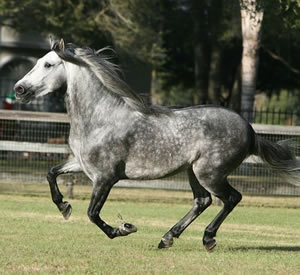General Description
Head: Should be refined and in good proportion to the body of the horse, neither extremely small nor large with the preferred profile being straight. Eyes are large and well spaced, very expressive and alert, and should not show excessive white around the edges. Ears are comparatively short, set close, and curved inward at the tips. The lips should be firm and the nostrils large and dilatable. Jaws are defined but not extreme. The impression should be of a well-shaped, alert, and intelligent face.
Neck: Should be gracefully arched, medium in length and set on at an angle to allow high carriage, breaking at the poll. Throat latch should be refined and well-defined. Shoulders are sloping into the withers with great depth through the heart. Chest is moderate in width.
Withers: Defined but not pronounced and slope smoothly into the back. The midsection is moderate in length with a well-sprung rib cage. the topline should be proportionately shorter than the underline. The back should be b and muscled. The midsection should join the forehand and the hindquarters so as to give the horse a pleasing, proportioned appearance.
Hindquarters: The croup is slightly sloping with rounded hips, broad loins, and b hocks. The tail is carried gracefully when horse is in motion.
Legs: Straight with refined bones and broad, well defined tendons and broad, long fore-arms with shorter cannons. Thigh and gaskins are broad and muscled, but not exaggerated. Standing slightly under in the rear is typical. Pasterns are sloping and medium in length. Bones are straight, sound and flat, and joints are b and well defined. The hooves are well rounded, proportionate in size, and do not show excessive heel.
Mane, Tail and Forelock: Should be as long, full and luxurious as nature can provide. No artificial additions or alterations are allowed. A bridle path not exceeding 4" is acceptable.
Size: Ranges from 13 to 15.2 hands with 13.3 to 15 being the most typical. Weight ranges from 700 to 1100 lbs. Full size may not be attained until the fifth year.
Color: Every equine color can be found, with or without white markings. The disposition of the Paso Fino is marked by an extremely willing horse that truly seems to enjoy human companionship and strives to please. Spirited and responsive under tack; sensible and gentle at hand.
Movement: The Paso Fino is a four-beat lateral gait, the birthright of every Paso Fino. Newborn foals struggle to their feet and take their first faltering steps in gait.
The Paso Fino executes a natural evenly spaced four-beat lateral ambling gait, similar to many gaited horses. Both the Colombian and the Puerto Rican strains of the Paso Fino execute the lateral gait naturally, without the aid of training devices.
The Paso Fino's gaits are performed at varied levels of extension in stride. All four hooves travel close to the ground while in motion and are lifted equally in height as the horse covers ground. At whatever speed the horse travels, the smoothness of the gait ideally allows the rider to appear motionless with little up and down movement.
Paso Fino performing Classic FinoThe classic fino or paso fino is a collected gait with rapid footfalls that covers as little ground as possible. It requires a high degree of collection. This is a show gait reserved for competition. Walking, trotting, cantering or any detected break from the rapid evenly spaced sequence of steps is grounds for disqualification at any time during a fino event.
The paso corto is slightly more extended, and used during trail rides. The speed of this gait is comparable to the speed of a trot but is much smoother.
The paso largo is a fast, lateral, four-beat gait in which the horse can reach speeds equivalent to a canter or slow gallop. The paso largo is not just an increase in speed but also shows a distinct extension in stride. The paso largo can be extremely fast, up to 25-30 mph.
Only a few Paso Finos can perform a true classic fino, but the majority perform the other gaits with ease. The correctness of the gait is very important by today's standards, therefore horses with a very even four-beat gait are much preferred for professional breeding.
In Colombia, some related native horses perform a slightly different, unevenly timed diagonal four-beat gait, known as the trocha, which is similar to the fox trot, and very smooth. While some Paso Finos will perform the trocha, it is discouraged and considered a fault in the purebred Paso Fino. In Colombia the "trocha" has evolved, becoming a separate genealogical line. It is inherited in a manner similar to the lateral ambling gaits of the purebred Paso Fino. Trocha rivals in popularity with paso fino in Colombia, but crossbreeding is now avoided. Another Colombian breed performs what is known as trote y galope. The trote y galope horses perform an exaggerated diagonal two-beat trot and a very collected canter, but they do share some common heritage with the Paso Fino. Not as well known as Paso Fino, these variants are just beginning to be recognized in the United States.






